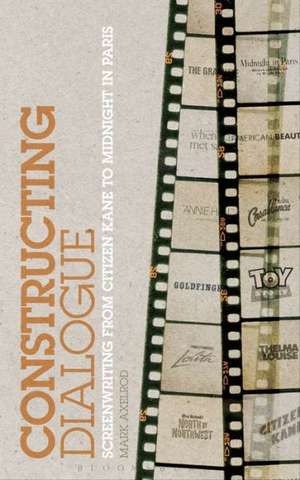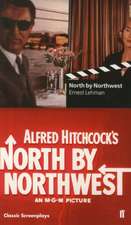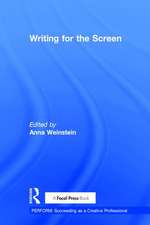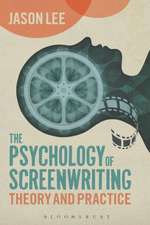Constructing Dialogue: Screenwriting from Citizen Kane to Midnight in Paris
Autor Mark Axelroden Limba Engleză Hardback – 2014
| Toate formatele și edițiile | Preț | Express |
|---|---|---|
| Paperback (1) | 169.48 lei 6-8 săpt. | |
| Bloomsbury Publishing – 2014 | 169.48 lei 6-8 săpt. | |
| Hardback (1) | 571.66 lei 6-8 săpt. | |
| Bloomsbury Publishing – 2014 | 571.66 lei 6-8 săpt. |
Preț: 571.66 lei
Preț vechi: 728.12 lei
-21% Nou
Puncte Express: 857
Preț estimativ în valută:
109.41€ • 112.76$ • 92.37£
109.41€ • 112.76$ • 92.37£
Carte tipărită la comandă
Livrare economică 03-17 martie
Preluare comenzi: 021 569.72.76
Specificații
ISBN-13: 9781441174253
ISBN-10: 1441174257
Pagini: 328
Dimensiuni: 152 x 229 x 25 mm
Greutate: 0.66 kg
Ediția:New.
Editura: Bloomsbury Publishing
Colecția Bloomsbury Academic
Locul publicării:New York, United States
ISBN-10: 1441174257
Pagini: 328
Dimensiuni: 152 x 229 x 25 mm
Greutate: 0.66 kg
Ediția:New.
Editura: Bloomsbury Publishing
Colecția Bloomsbury Academic
Locul publicării:New York, United States
Caracteristici
Covers
screenplays
from
the
last
70
years,
includingJules
&
Jim,
Sunset
Boulevard,
Thelma
and
Louise,
LolitaandMidnight
in
Paris
Notă biografică
Mark
Axelrod
is
a
Full
Professor
of
English
and
Comparative
Literature,
and
Director
of
the
John
Fowles
Center
for
Creative
Writing,
at
Chapman
University,
USA.
Cuprins
1.
Introduction
2.Citizen
Kane(1941)
Herman
J.
Mankiewicz,
Orson
Welles
3.Casablanca(1942)
Murray
Burnett,
Joan
Alison,
Julius
J.
Epstein,
Philip
G.
Epstein,
Howard
Koch,
Casey
Robinson
4.Sunset
Boulevard(1950)
Billy
Wilder
5.North
by
Northwest(1959)
Ernest
Lehman
6.Jules
&
Jim(1962)
François
Truffaut,
Jean
Gruault
7.Lolita(1963)
Vladimir
Nabokov,
Stanley
Kubrick
8.Goldfinger(1964)
Richard
Maibaum,
Paul
Dehn
9.The
Graduate(1969)
Calder
Willingham,
Buck
Henry
10.Midnight
Cowboy(1969)
Waldo
Salt
11.Chinatown(1973)
Robert
Towne12.Annie
Hall(1977)
Woody
Allen,
Marshall
Brickman
13.When
Harry
Met
Sally(1989)
Nora
Ephron
14.The
Fisher
King(1991)
Richard
LaGravanese
15.Thelma
&
Louise(1991)
Callie
Khouri
16.Toy
Story(1995)
John
Lasseter
17.Good
Will
Hunting(1997)
Matt
Damon,
Ben
Affleck
18.Run
Lola
Run(1998)
Tom
Tykwer
19.American
Beauty(1999)
Alan
Ball
20.Midnight
in
Paris(2010)
Woody
Allen
ExercisesScreenplay
BibliographyIndex
Recenzii
Constructing
Dialoguereveals
unprecedented
insights
into
the
pivotal
impact
of
dialogue
on
cinematic
craftsmanship.
Axelrod's
nuanced
analysis
of
great
Hollywood
scripts
investigates
dialogue
as
an
active
tactical
element
that
operates
with,
rather
than
against,
visual
artistry.
At
once
gleeful,
rigorous
and
practical,
Axelrod
shows
that
the
best
feature
screenplays
are
structured
down
to
even
the
"micro"
level
of
a
single
well-crafted
line.
Crucial
reading
for
aspiring
screenwriters,
film
students,
seasoned
filmmakers
and
film
buffs
alike,
Axelrod
uncovers
the
bare
bones
of
the
screenplay,
the
writer's
ecstatic
dance
with
words,
structure
and
story.
I wish I could have had at hand such a great screenwriting guide in my first steps as a student and filmmaker. It could have saved me a lot of trouble, by speeding up my own development in this area. Script doctor and visionary creative writer Axelrod provides the art of motion pictures - and film industry in general - with a unique guide that will certainly expand film possibilities over the years to come. Axelrod's book on dialogue construction can perfectly match Joseph Campbell's revolutionary writings that changed film narrative forever.
Axelrod does what Axelrod does best: knows dialogue. This unique text elucidates what the preeminent screenwriters have known and accomplished for years; namely, how to say the most with brevity and precision and move the story along. Axelrod shows that in a very succinct, if not unique, way. Anyone interested in the art of dialogue writing should read this.
I wish I could have had at hand such a great screenwriting guide in my first steps as a student and filmmaker. It could have saved me a lot of trouble, by speeding up my own development in this area. Script doctor and visionary creative writer Axelrod provides the art of motion pictures - and film industry in general - with a unique guide that will certainly expand film possibilities over the years to come. Axelrod's book on dialogue construction can perfectly match Joseph Campbell's revolutionary writings that changed film narrative forever.
Axelrod does what Axelrod does best: knows dialogue. This unique text elucidates what the preeminent screenwriters have known and accomplished for years; namely, how to say the most with brevity and precision and move the story along. Axelrod shows that in a very succinct, if not unique, way. Anyone interested in the art of dialogue writing should read this.



















